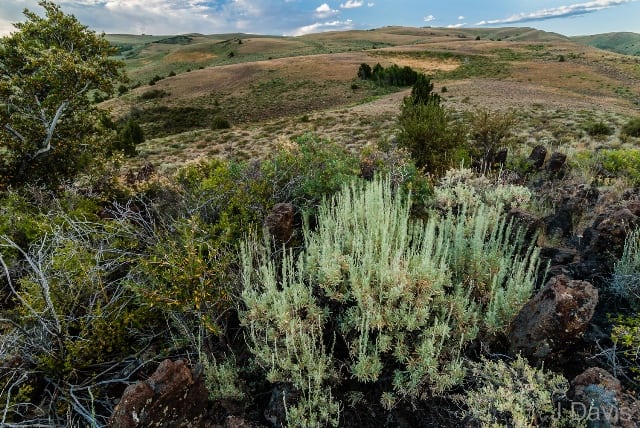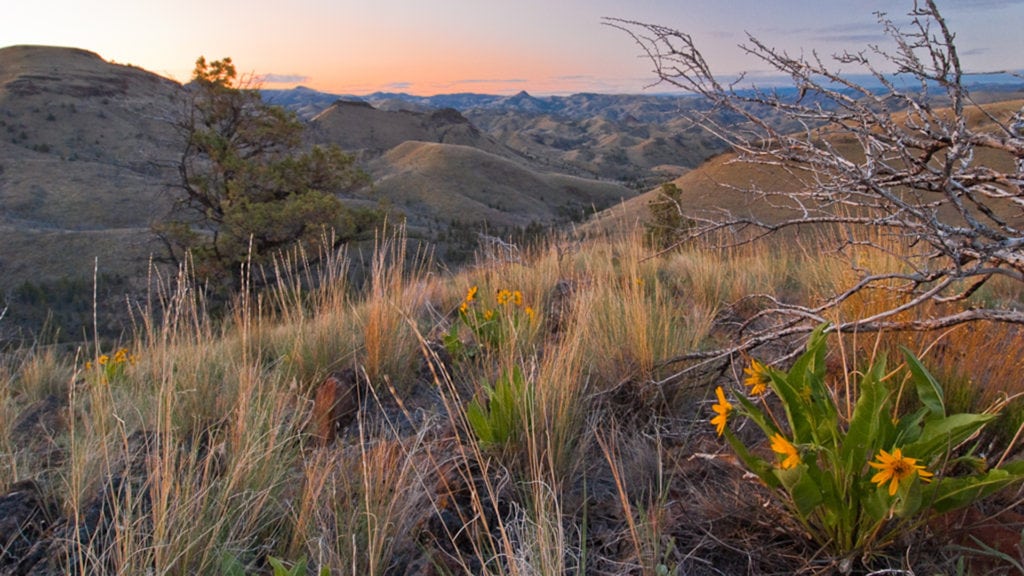
Dr. Megan Creutzburg is a researcher at Oregon State University’s Institute for Natural Resources, where she provides technical coordination for the Oregon Sage Grouse Conservation Partnership (SageCon). With climate marches happening across the nation on Saturday, ONDA’s Corinne Handelman sat down with Megan for an interview about her research on sagebrush landscapes and climate change impacts. The interview has been edited and condensed.
First off, can you tell me a bit about yourself and how you came to study sagebrush landscapes?
Yes! I was surrounded by sagebrush while I was in graduate school at Utah State University and ended up interning with The Nature Conservancy toward the end of graduate school to look at the long-term implications of management actions in sagebrush landscapes. From there, I was hired at the Institute for Natural Resources, where I used computers to model multiple processes that influence rangeland plant communities – things like fire, drought, vegetation community shifts, and management. Right now I am working as the technical coordinator for SageCon, where I help coordinate among the different agencies and stakeholders interested in addressing threats to sage-grouse, and help build technical tools to track data and provide monitoring information about sagebrush habitat.
As I understand it, there are two types of sagebrush ecosystems based on moisture. What are the main differences between them?
That’s true. When you first look at sagebrush, it seems pretty uniform, but there are two main categories of sagebrush steppe (ecosystems dominated by sagebrush shrubs and perennial bunchgrasses) that differ in their plant dynamics. First, the majority of sagebrush is in a warm and dry landscape with sparsely distributed sagebrush shrubs and perennial bunchgrasses. These systems aren’t very resilient, they are slow to recover after impacts, and they aren’t as hardy to resist disturbances. The other type is less abundant; it is the cooler and wetter systems where juniper can survive and there’s more sagebrush and grass cover. This means there’s less bare open ground, and it can recover more quickly from outside impacts since there’s more water available to support the plants.
 What are current threats to sagebrush ecosystems, and are they different for the wet and dry types?
What are current threats to sagebrush ecosystems, and are they different for the wet and dry types?
Unfortunately, both of these sagebrush types are under threat, but the threats are pretty different. In the drier sagebrush systems, invasive species such as cheatgrass can move in and fill the gaps between native plants. This is a problem because cheatgrass dries early in the season, is an early colonizer after disturbances, and basically creates a contiguous, flammable surface that can increase the likelihood and severity of fires. Since these species are often good at colonizing after a disturbance, they both promote and benefit from increased wildfire in a positive feedback loop. In wetter sagebrush systems, junipers have been moving in and crowding out sagebrush. In these areas, juniper has spread beyond its historic extent, mostly due to modern fire suppression and gradual increases in rainfall over the last century.
Can you explain the dynamic between fire and invasive species a bit more?
Fire is a natural disturbance, but more recently there have been changes in the location, frequency and extent of fires. Historically, there was infrequent fire in warmer, drier sagebrush areas because the vegetation is often sparse, with spaces between grasses and sagebrush plants creating natural fire breaks. Now, invasive species like cheatgrass fills those gaps with a flammable plant and fire becomes more frequent and spreads across larger areas more regularly. On the flip side, the moist sites historically had more frequent fire that kept juniper restricted to the edges of the sagebrush dominated areas. Invasive species there are less of a problem, but less frequent fire as a result of fire suppression has allowed juniper to move in and take over sagebrush systems.
 So these impacts are already happening. Do we know how climate change and current threats will interact?
So these impacts are already happening. Do we know how climate change and current threats will interact?
With climate change, we can expect that these main threats of invasive species, juniper encroachment, and wildfire are likely to accelerate. Some invasive grasses seem to disproportionately benefit from higher atmospheric carbon dioxide and higher temperatures. Juniper will likely also benefit from increasing temperatures and rainfall. And these two threats, which have largely affected different areas on the landscape so far, are likely to converge, so we will find areas that are affected by both juniper and cheatgrass with less of the sagebrush and native grasses present. These areas will be harder to manage and have the risk of going from one undesirable outcome to the other. Also, we have a lot of evidence that climate change will likely lead to bigger fires. We also can expect that there will be more extreme weather events overall, either as droughts or big rain events.
It sounds like there’s a lot happening across our sagebrush landscapes! Why do you think this sagebrush landscape so important to protect?
I think it’s easy for some people to dismiss the sagebrush sea as a vast monotonous landscape, but really when you’re out there you see a dynamic system that can be hard to appreciate. Sometimes, there will be big wildflower bloom events — and I’d expect to see that this year — but the beauty can be hidden. Sometimes you need to be in the right time or place to appreciate it, but the sagebrush steppe is home to a huge diversity of plant and animal life. And protecting the sagebrush landscape can preserve the way of life in our rural communities. Preserving the sagebrush steppe and addressing these threats is beneficial for both wildlife and people.
—
Consider giving a gift to propel science-based conservation initiatives at ONDA.org/donate.